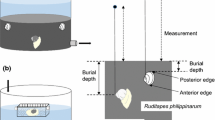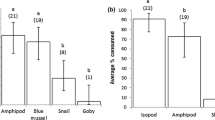Abstract
Interactions of the predator Lineus viridis (O. F. Muller 1774) with infaunal polychaetes were investigated in the German Wadden Sea. L. viridis is the dominant heteronemertean in this intertidal area with a mean abundance of 14 individuals per square meter. Predator enclosure experiments in the field revealed that L. viridis preyed on predatory polychaetes. The preferred prey species was Nereis diversicolor; others were Anaitides maculata. Nephtys hombergii and Harmothoe sarsi. These results were supported by a series of feeding experiments in the laboratory. The rate of consumption was estimated by laboratory and field experiments. The feeding rate of Lineus viridis was estimated by laboratory enclosure experiments to 5.6 g ashfree dry weight (AFDW) per square meter annually.
Similar content being viewed by others
References
Ambrose, W. G., 1984. Influences of predatory polychaetes and epibenthic predators on the structure of a soft-bottom community in a marine estuary. J. Exp. Mar. Biol. Ecol. 81: 115–145.
Asmus, H., 1984. Freilanduntersuchungen zur Sekundärproduktion und Respiration benthischer Gemeinschaften im Wattenmeer der Nordsee. Berichte a.d. Institut f. Meereskunde a.d. Christian-Albrechts-Universität Kiel Nr. 122.
Bartsch, I., 1973. Zur Nahrungsaufnahme von Tetrastemma melanocephala (Nemertini). Helgoländ wiss. Meeresunt. 25: 326–331.
Bartsch, I., 1977. Die Biologie des Nemertinen Tetrastemma melanocephalum (Johnston). Faun. ökol. Mitt. 5: 125–128.
Beukema, J. J., 1981. Quantative data on the benthos of the wadden sea proper. The role of larger invertebrates in the wadden-sea ecosystem. In: N. Dankers & H. Kohl (eds), Invertebrates of the wadden sea. A. A. Balkema, Rotterdam.
Crisp, D. J., 1971. Energy flow measurement. Methods for the study of marine benthos. 1. Balanus glandula and several predotory species of Thais. Ecol. Monogr. 40: 49–78.
Dugan, P. J., 1981. The importance of nocturnal feeding in shorebirds: A consequence of increased invertebrate prey activity. In: N. V. Jones & W. J., Wolff (eds) Feeding and survival strategies of estuarine organisms. Plenum Press, New York: 251–260.
Gontcharoff, M., 1948. Note sur l'alimentation de quelque nemertes. Ann. Sci. Natur. Paris, Series 11, 10: 75–78.
Hartmann-Schröder, B., 1971. Annelida, Borstenwürmer Polychaeta. In: Tierwelt der Nord.- und Ostsee. Dahl. F.u.a. VEB Gustav Fischer Verlag Jena.
Jennings, J. B., 1960. Observations on the nutrition of the rhynchocoelan Lineus ruber (O.F. Müller) Biol. Bull. 119: 189–196.
Kem, W., 1973. Biochemistry of Nemertine toxins. In Martine & Padilla (eds) Marine Pharmacognosy 1973: 37–84.
Kristensen, E., 1984. Life cycle, growth and production in estuarine populations of the polychaetes Nereis virens and Nereis diversicolor. Holarct. Ecol. 7: 249–256.
McDermott, J. J., 1976. Observations on the food and feeding behavior of estuarine nemertine worms belonging to the order hoplonemertea. Biol. Bull. 150: 57–68.
McDermott, J. J., & P. Roe, 1985. Food, feeding behavior and feeding ecology of nemerteans. Amer. Zool. 25: 113–125.
Moretto, H. J. A. & G. Vernet, 1985. Les cellules asconiformes de la trompe des Heteronemertes du genre Lineus: Aspectes Morphologiques et Fonctionals, Bull. Soc. Zool. Fr. 110: 129–138.
Peterson, C. H., 1979. Predation, competitive exclusion, and diversity in the soft sediment benthic communities of estuaries and lagoons. In: R. C. Livingstone (ed.), Ecological Process in Coastal and Marine Systems. Plenum Press, New York: 233–264.
Prezant, R. S., 1979. An antipredation mechanism of the polychaete Phyllodoce mucosa with notes on similar mechanisms in other potential prey. Fish. Bull. 77: 605–616.
Prezant, R. S., 1981. Predator repellents of benthic macroinvertebrates. Am. Zool. 21: 1022.
Reise, K., 1977. Predation pressure and community structure of an intertidal soft bottom fauna. In B. F. Keegan, P. O'Ceidigh & P. G. S. Boadan (eds), Biology of benthic organisms. Pergamon Press, New York: 513–519.
Reise, K., 1979. Spatial configurations generated by mobile benthic polychaetes. Helgoländer wiss. Meeresunt. 32: 55–72.
Reise, K., 1979. Tidal ecology. Ecological studies, Vol. 54. Springer, Berlin, 191 pp.
Roe, P., 1970. The nutrition of Paranemertes peregrina (Rhynchocoela: Hoplonemertea). 1. Studies on food and feeding behaviour. Biol. Bull. 139: 80–91.
Roe, P., 1976. Life history and predator-prey interactions of the Nemertean Paranemertes Peregrina Coe. Biol. Bull. 150: 80–106.
Sachs, L., 1984. Angewandte Statistik. Springer, Berlin, 552 pp.
Sumerson, H. C. & C. H. Peterson, 1984. Role of predation in organizing benthic communities of a temperate zone seagrassbed. Mar. ecol. Progr. Ser. 15: 63–77.
Wohlenberg, E., 1937. Die Wattenmeer-Lebensgemeinschaften im Königshafen von Sylt. Helgoländer. wiss. Meeresunt. 1: 1–92.
Author information
Authors and Affiliations
Rights and permissions
About this article
Cite this article
Nordhausen, W. Impact of the nemertean Lineus viridis on its polychaete prey on an intertidal sandflat. Hydrobiologia 156, 39–46 (1988). https://doi.org/10.1007/BF00027976
Issue Date:
DOI: https://doi.org/10.1007/BF00027976




